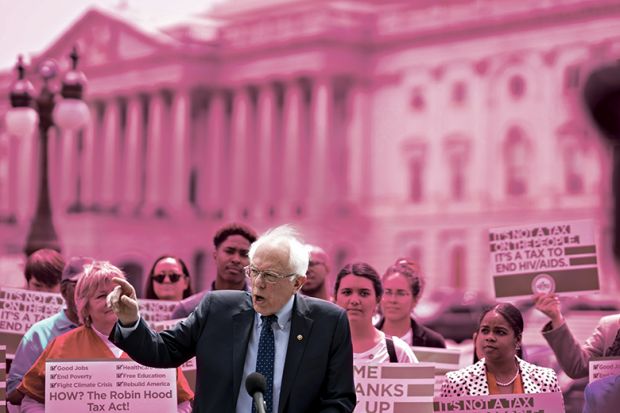With Bernie Sanders’ hopes of becoming the next US president in sharp decline, so is the likelihood that the US will implement free public higher education any time soon.
Making study at college and university debt-free should have been an easy pitch for the man vying with Joe Biden to be the Democrats’ presidential nominee. It hasn’t been. A December 2019 poll carried out by The New York Times found that only just over 30 per cent of the US public agree that public higher education should be free to all. Even some public higher education leaders are against the idea. Daniel J. Hurley, CEO of the Michigan Association of State Universities, has described the proposal as “over-populist”.
If few US voters, even on the left, have bought into Sanders’ revolutionary plan for higher education, it likely reflects the fact that it is incompatible with the nation’s reputation-obsessed and market-driven approach to higher education.
Like it or not, US degrees with high price tags are associated with greater prestige, better networking opportunities and a brighter future. If you ask the average American about the best universities in the country, they will nearly always list a private Ivy. And notwithstanding a few exceptions, the best US universities do cost more.
In Times Higher Education’s most recent ranking of world universities, there are 16 US institutions in the top 25, but only three are public institutions. The same holds true for four-year colleges. According to US News and World Report, with the exception of two military institutions, all 25 top-ranked four-year colleges are private, and most carry price tags well over $50,000 annually for tuition alone.
Colleges aren’t just places that people go to learn. They are places where elites go to network. If you want a successful career in politics, for example, you might be able to get there with public degrees: Sanders’ former rival for the Democratic nomination, Elizabeth Warren, only has degrees from public institutions. But, so far, only one US president of the modern era, Gerald Ford, has arrived in the Oval Office without at least one degree from a private US university or military college (and he, of course, didn’t win a general election). Even Sanders has a degree from a private institution, the University of Chicago, where the average cost of attendance now tops $80,000 annually.
There is also evidence that spending more on your own education may even yield a higher return on investment. A 2019 study of 4,500 US colleges and universities, carried out by the Center on Education and the Workforce at Georgetown University, found that graduates of private non-profit institutions have a “sizable edge in earnings 10 years after enrollment”, even though median debt levels at public institutions are considerably lower.
Hence, for Sanders’ higher education plan to have mass appeal, all US public universities – not just a few outliers like the University of California, Berkeley and the University of Michigan – would need to be embraced as the very best options for people whether or not they can afford to pay. Sadly, this seems highly unlikely for one key reason – endowment funds.
US colleges and universities rely heavily on these. In 2019, roughly one-third of Harvard University’s operating budget came out of investment income. At Yale, up to 90 per cent of some programmes rely on it. Some of the best public universities also rely on endowment funds: Michigan, for instance, derives 14.5 per cent of its operating budget from funds associated with its endowment, although this is very much at the high end of the scale. Such funds are tapped to create research chairs, expand and update campus buildings, and establish state-of-the-art facilities and research labs.
To appreciate why Sanders’ plan for higher education has likely failed to attract more supporters, it is useful to compare the two-tiered US system to the public higher education system that already exists north of the border in Canada. While Canadian higher education isn’t free, it is comparatively accessible. More importantly, tuition at the very best and very worst Canadian schools is more or less the same; high price tags aren’t equated with a better education.
In addition, while Canadian institutions do rely on endowment funds, even at the top-ranked institutions they represent a small fraction of the operating budget. In 2018-19, only 2.4 per cent of the University of Toronto’s operating revenue came from its endowment, for instance. Hence, if Canadian higher education became free tomorrow, not much would change because the system is already more or less detached from the market economy.
For Sanders’ plan to work, US higher education will ultimately need to become similarly detached. As long as the public believes that high price tags open more doors and even offer a better return on investment, and as long as donations from wealthy alumni remain a core part of institutional operating budgets, free college will remain incompatible with the realities of the US system.
Kate Eichhorn is associate professor and director of culture and media studies at The New School in New York City.
Register to continue
Why register?
- Registration is free and only takes a moment
- Once registered, you can read 3 articles a month
- Sign up for our newsletter
Subscribe
Or subscribe for unlimited access to:
- Unlimited access to news, views, insights & reviews
- Digital editions
- Digital access to THE’s university and college rankings analysis
Already registered or a current subscriber? Login








